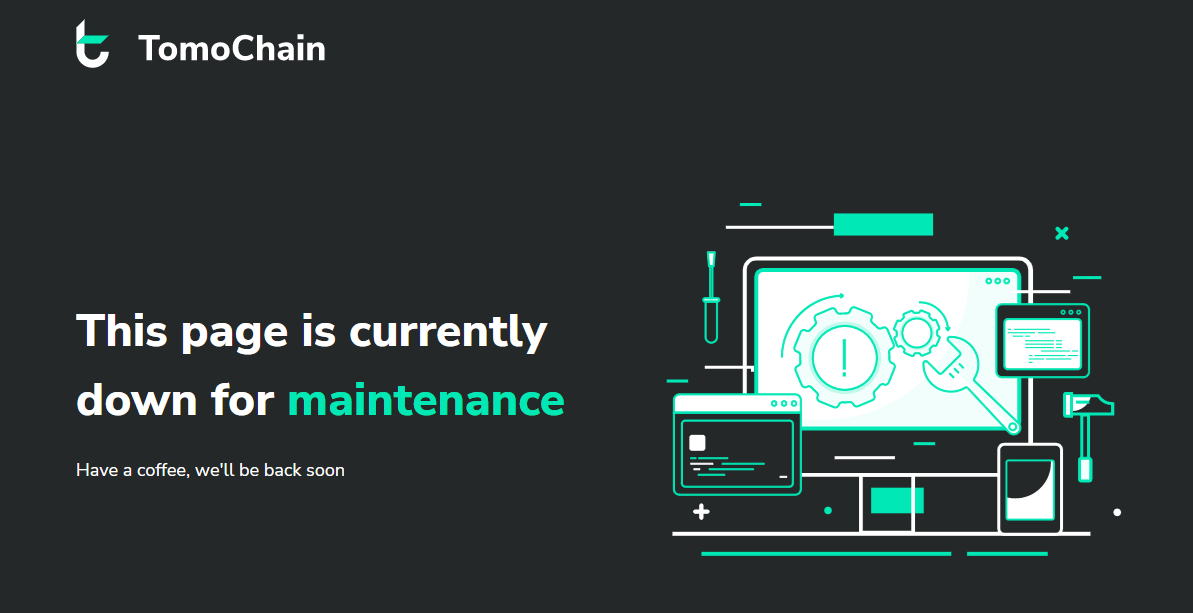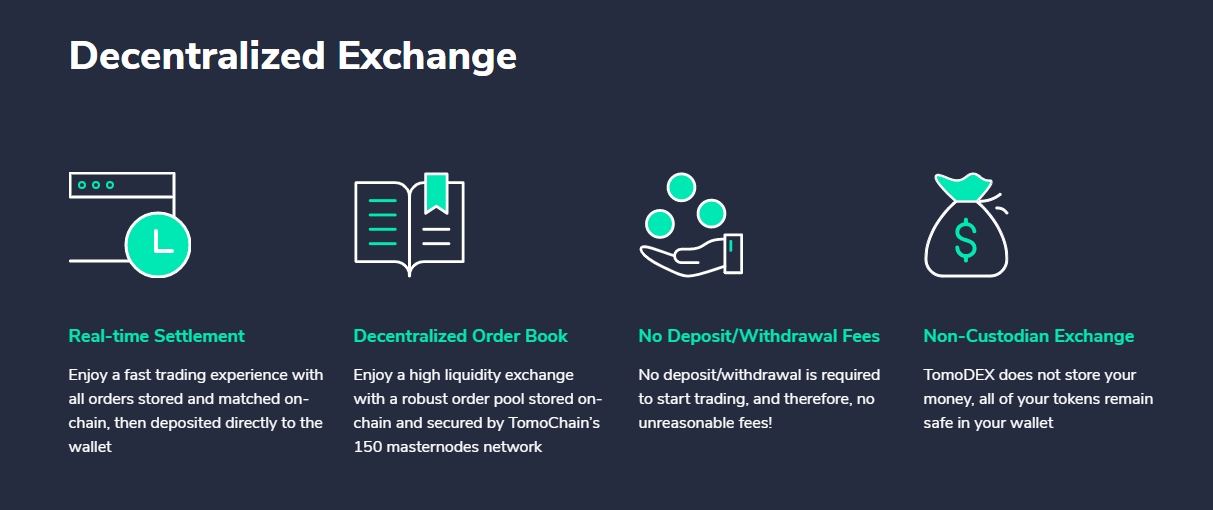
TomoDEX
एक्सचेंज फीस
जमा करने के तरीके
समर्थित क्रिप्टोकरेंसी (7)
UPDATE 23 March 2023: TomoDEX has been "down for maintenance" for several months in a row. Therefore, we think that they are not only down for maintenance, but actually just down. Period.

Accordingly, we have marked the platform as "dead" in our Exchange Graveyard. If the exchange's website would become accessible again and the error is just temporary, we will "revive" it and bring it back to our Exchange List.
To find a reliable exchange where you can start an account, just use our Exchange List and we'll help you find the right platform for you.
TomoDEX Review
What is TomoDEX?
TomoDEX is a decentralized exchange (DEX) that launched in the "DeFi Year" of 2020. With the TomoDEX, you can trade, borrow and earn directly from your wallet. The platform is entirely non-custodial, meaning that they never hold custody over any of your assets.

General Information on DEXs
DEXs are becoming increasingly more popular, mostly due to the following factors:
- They do not require a third party to store your funds, instead, you are always directly in control of your coins and you transact directly with whoever wants to buy or sell your coins.
- They normally do not require you to give out personal info. This makes it possible to create an account and right away be able to start trading.
- Their servers spread out across the globe leading to a lower risk of server downtime.
- They are essentially immune to hacker attacks.
However, DEXs normally have an order book with lower liquidity than their centralized counterparts.
TomoDEX Compatible Wallets
In order to use TomoDEX you need to have one of the following wallets (Trezor is the only wallet listed under "Others". The platform is only possible to use if you connect your wallet to the platform.

TomoDEX Liquidity
As for TomoDEX, on the date of first writing this review (26 February 2021), the 24 hour trading volume was USD 2,207 (according to information from coinmarketcap.com). You read that right, 2,207 dollars. On the date of updating this review (12 September 2021), Coinmarketcap had labelled the platform as an "Untracked Listing" with no published information on the trading volume.
The liquidity at this exchange essentially means that the exchange is not really active. We do not recommend anyone to start an account with TomoDEX until their liquidity improves.
US-investors
Why do so many exchanges not allow US citizens to open accounts with them? The answer has only three letters. S, E and C (the Securities Exchange Commission). The reason the SEC is so scary is because the US does not allow foreign companies to solicit US investors, unless those foreign companies are also registered in the US (with the SEC). If foreign companies solicit US investors anyway, the SEC can sue them. There are many examples of when the SEC has sued crypto exchanges, one of which being when they sued EtherDelta for operating an unregistered exchange. Another example was when they sued Bitfinex and claimed that the stablecoin Tether (USDT) was misleading investors. It is very likely that more cases will follow.
Decentralized exchanges are different beings than the abovementioned examples. They never have custody of any user assets. They normally don't accept any fiat currency. As such, they are less scary for regulating authorities and the same reasons to prohibit citizens from certain countries to use them can't be applied. Accordingly, we have marked TomoDEX as "allowing US-investors" in our database.
TomoDEX Trading View
Every trading platform has a trading view. The trading view is the part of the exchange’s website where you can see the price chart of a certain cryptocurrency and what its current price is. There are normally also buy and sell boxes, where you can place orders with respect to the relevant crypto, and, at most platforms, you will also be able to see the order history (i.e., previous transactions involving the relevant crypto). Everything in the same view on your desktop. There are of course also variations to what we have now described. This is the trading interface at TomoDEX (with no wallet connected though):

TomoDEX Fees
TomoDEX Trading fees
When it comes to centralized exchanges, many of them charge what we call taker fees, from the takers, and what we call maker fees, from the makers. Takers are the people removing liquidity from the order book by accepting already placed orders, and makers are the ones placing those orders. The main alternative to this is to simply charge “flat” fees. Flat fees mean that the exchange charges the taker and the maker the same fee.
When it comes to decentralized exchanges, many of them don't charge any trading fees at all. This is in fact one of the big arguments that DEX-supporters use to explain why centralized exchanges are on their way out.
TomoDEX does charge a trading fee, but it's quite modest: 0.10%.
TomoDEX Withdrawal fees
To our understanding, TomoDEX does - like most decentralized exchanges - not charge any transfer fees or withdrawal fees other than the network fees. The network fees are fees paid to the miners of the relevant crypto/blockchain, and not fees paid to the exchange itself. Network fees vary from day to day depending on the network pressure.
Generally speaking, to only have to pay the network fees should be considered as below global industry average when it comes to fee levels for crypto withdrawals (if you include all exchanges, both DEXs and CEXs in the data set).

Deposit Methods
TomoDEX does not – like all (or at least close to all) other DEXs – accept any deposits of fiat currency. This means that crypto investors without any previous crypto holdings can’t trade at this trading platform. In order to purchase your first cryptos, you need a so called entry-level exchange, which is an exchange accepting deposits of fiat currency. Find one by using our Exchange Filters!
TomoDEX Security
The servers of DEXs normally spread out across the globe. This is different from centralized exchanges that normally have their servers more concentrated. This spread-out of servers leads to a lower risk of server downtime and also means that DEXs are virtually immune to attacks. This is because if you take out one of the servers, it has little to no impact on the full network. However, if you manage to get into a server at a centralized exchange, you can do a lot more harm.
Also, if you make a trade at a DEX, the exchange itself never touches your assets. Accordingly, even if a hacker would somehow be able to hack the exchange (in spite of the above), the hacker can not access your assets. If you make a trade at a centralized exchange, however, you normally hold assets at that exchange. That is, until you withdraw them to your private wallet. A centralized exchange can therefore be hacked and your funds held at such exchange can be stolen. This is not the case with respect to decentralized exchanges, like TomoDEX.